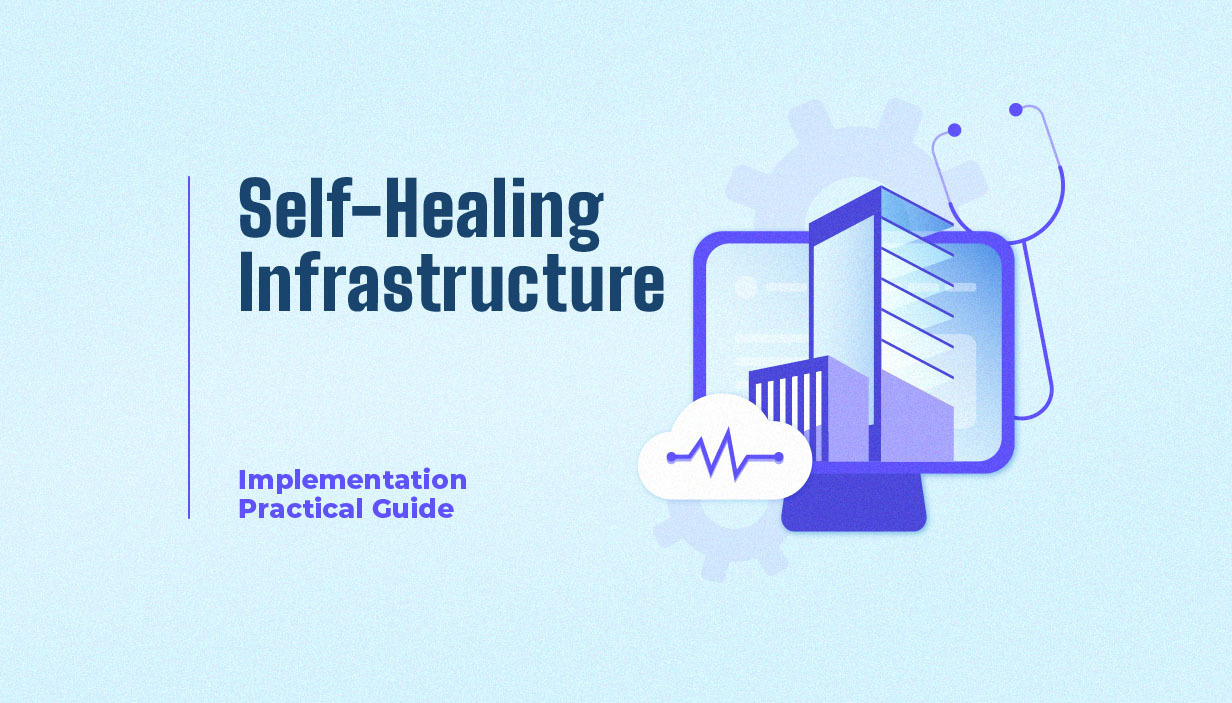Self-healing infrastructure represents the next natural progression in IT operations, shifting teams away from repetitive manual intervention and toward automation-driven resilience. By implementing self-healing systems, organizations can reduce downtime, repair errors automatically, and reallocate up to 30% of IT staff time from service desks to strategic initiatives. This proactive approach transforms reactive firefighting into intelligent process automation, allowing IT teams to focus on innovation while maintaining uninterrupted operations and service level agreements.
Self-healing infrastructure constantly monitors, analyzes, and resolves issues before they escalate into operational problems. These self-healing mechanisms, powered by artificial intelligence and machine learning algorithms, enhance system health, deliver predictive analytics, and support cost efficiency across complex IT environments. Kubernetes environments, for instance, benefit significantly from these self-healing capabilities, as CTO2B’s advanced Cluster API (CAPI) ensures ongoing reconciliation of system states through controllers that continuously assess underlying infrastructure and networking components.
This guide offers a practical, phased approach for implementing self-healing infrastructure, using CTO2B’s enterprise-grade platform as a unified solution overview. By combining predictive insights, automated actions, and AI-driven systems, organizations can build self-healing IT systems that reduce operational costs, automate root cause analysis, and achieve optimal performance with less human intervention.
Key Takeaways
- Foundation First: Register your systems with the CTO2B Cloud Console, install the Remote Host Configuration client, and subscribe to the Automation Platform. This ensures your environment is ready for continuous monitoring and automated responses.
- Proactive Detection: Use CTO2B’s advanced monitoring tools and analytics engine to compare historical data against baselines, enabling predictive analytics to identify root causes of anomalies before they escalate.
- Automated Response: Allow the system to generate auto remediation playbooks that implement corrective actions automatically, reducing manual tasks and ensuring issues are resolved without delay.
- Measurable Impact: Organizations leveraging these self-healing systems cut patching windows from entire weekends to two hours, while freeing IT teams to focus on strategic initiatives instead of operational issues.
- Continuous Protection: Through baseline enforcement and event-driven remediation, systems prevent configuration drift, maintain compliance, and keep healing infrastructure aligned with security events and performance metrics.
System Preparation for Self-Healing Capabilities
Implementing self-healing infrastructure requires careful preparation of the environment, ensuring monitoring tools, automation engines, and IT operations frameworks are properly aligned. This preparation minimizes reliance on manual tasks and builds the ability for systems to resolve issues independently.
Registering Systems with CTO2B Platform
The first step in implementing self-healing is registering all systems with CTO2B’s unified platform. This monitoring platform acts as a complete set of capabilities covering hosts, servers, networking components, and workloads across hybrid IT environments. Proper registration ensures uninterrupted operations and lays the groundwork for automated responses.
System registration requires:
- Administrative access and network connectivity
- Correct time synchronization on hosts
- SSL/TLS certificates for secure system communication
After executing registration commands with environment-specific activation keys, administrators can verify that systems are visible within the platform, enabling the next natural progression toward self-healing capabilities.
Installing CTO2B Monitoring Agent
The monitoring agent is the heartbeat of self-healing IT systems, continuously collecting telemetry that drives predictive analytics and auto remediation. While modern cloud deployments support automated installation, legacy systems may require manual steps:
curl -s https://get.cto2b.io/agent | sudo bash
For modern environments:
cto2b-cli install monitoring-agent
Register your system with CTO2B platform:
cto2b-agent --register
Once active, the agent ensures consistent data flow without overloading system health, balancing monitoring and performance metrics.
Configuring CTO2B Automation Engine
Automation is the foundation of reducing human intervention in today’s dynamic IT operations. After registration, CTO2B’s Automation Engine enables process automation that converts performance metrics and anomaly detection into self-healing mechanisms.
cto2b-cli list --available --all | grep "Automation Engine" -B 3 -A 6
Enable automation:
cto2b-cli enable-automation --tier=<tier_id>
By enabling automation, IT teams unlock the ability to automate root cause resolution, turning detected potential issues into automated actions that maintain optimal performance.
Real-Time Monitoring with CTO2B Platform
Monitoring is the engine that powers self-healing processes. CTO2B delivers continuous monitoring across hybrid environments, giving IT teams the ability to stay ahead of issues with a complete set of data-driven insights.
Complete Visibility Across Hybrid Environments
CTO2B’s dashboard presents IT teams with real-time system health indicators: Error, Warning, or OK. Administrators gain instant visibility into root causes of anomalies, while predictive analytics identify deviations before they impact service level agreements. This unified platform ensures that both cloud and on-premise infrastructure benefit from uninterrupted operations and proactive issue resolution.
Automated Vulnerability and Compliance Scanning
Self-healing IT systems rely on continuous detection of vulnerabilities. CTO2B integrates SCAP-based scanning into its monitoring platform, automatically identifying compliance gaps. Reports generated in Asset Reporting Format allow IT teams to prioritize corrective actions. Instead of depending on human action, automated processes ensure faster remediation while reducing resource constraints.
Streamlined Patch Management and Automation
Traditional patching relies heavily on manual intervention, but self-healing systems powered by CTO2B automate the process end-to-end. Through lifecycle environments, updates are validated, tested, and deployed seamlessly. With automation playbooks, patches become corrective actions triggered by detected risks, ensuring operational issues are resolved before downtime occurs.
Smart Analytics That Prevent Problems Before They Happen
Self-healing capabilities are rooted in intelligence. CTO2B’s predictive analytics engine goes beyond simple monitoring by leveraging machine learning algorithms and historical data for proactive detection.
Configuration Drift Detection and Risk Assessment
By continuously analyzing configurations, CTO2B highlights drift and compares system states against established baselines. Historical data preserves snapshots of underlying infrastructure, supporting root cause analysis and allowing IT teams to repair errors and resolve issues with minimal human action.
Predictive Security and Performance Intelligence
CTO2B transforms monitoring data into actionable intelligence, assessing security events with business impact in mind. AI-driven systems not only detect vulnerabilities but also understand whether exploit conditions exist. This reduces false positives, helps IT teams stay ahead of threats, and ensures greater efficiency in addressing operational issues.
Cost Management and Resource Optimization
Self-healing infrastructure is also about cost efficiency. CTO2B monitors expenses across clusters, nodes, and projects, identifying unexpected spending spikes before they impact budgets. By coupling predictive analytics with cost management, IT teams achieve both operational efficiency and financial control.
Automated Remediation Using Ansible Playbooks
Generating Remediation Plans from CTO2B
When potential issues are identified, CTO2B automatically generates remediation plans using Ansible Playbooks. These playbooks outline corrective actions that transform detection into resolution without human intervention. By grouping compatible systems, IT teams ensure automated responses resolve issues consistently across environments.
Executing Playbooks via Ansible Automation Platform
Execution requires administrator permissions, validated through readiness checks for connectivity, role assignments, and monitoring platform integration. Once confirmed, playbooks trigger auto remediation to address operational issues immediately. This phased approach ensures that manual tasks are eliminated, replaced by automated actions that restore system health.
Maintaining System Integrity with Baseline Enforcement
Self-healing infrastructure maintains compliance through baseline enforcement. Event-driven remediation automatically corrects drift, while audit-ready documentation ensures regulatory alignment. This proactive approach ensures uninterrupted operations even when changes occur, minimizing dependency on human action.
How CTO2B Accelerates Self-Healing Infrastructure
CTO2B is more than a monitoring platform, it is a unified solution that delivers the complete set of self-healing capabilities modern IT environments demand. By combining AI-driven systems, machine learning algorithms, and predictive analytics, CTO2B enables organizations to implement self-healing infrastructure with confidence.
- Unified Monitoring and Automation: A single platform for monitoring tools, automation playbooks, and compliance enforcement, reducing tool sprawl.
- Proactive Analytics: Predictive intelligence that identifies potential issues early, ensuring teams stay ahead of operational risks.
- Auto Remediation: Automated responses that repair errors, resolve issues, and maintain system health without manual intervention.
- Operational Efficiency: IT teams reduce downtime, manage resource constraints, and focus on strategic initiatives instead of repetitive tasks.
With CTO2B, implementing self-healing infrastructure becomes a natural progression toward greater efficiency, cost efficiency, and uninterrupted operations in today’s dynamic IT environments.
Ready to Build Self-Healing Infrastructure?
Self-healing infrastructure is the next natural progression in modern IT operations. By embracing AI-driven systems, process automation, and predictive analytics, organizations achieve a proactive approach that reduces downtime, automates corrective actions, and ensures optimal performance across complex environments.
CTO2B delivers the ability to implement these solutions through a unified platform, enabling IT teams to focus on strategic initiatives while ensuring operational issues are resolved automatically. Whether managing resource constraints, reducing operational costs, or improving service level agreements, self-healing systems built on CTO2B offer a proven solution.
Contact CTO2B today to discover how self-healing infrastructure can optimize your operations and empower your teams.
FAQs
What is self-healing infrastructure and why is it important?
Self-healing infrastructure is an automated system that proactively monitors, analyzes, and fixes issues before they impact operations. It improves uptime, reduces operational costs, and allows IT teams to focus on innovation rather than manual intervention.
How do you prepare your systems for implementing self-healing capabilities?
Preparation involves registering systems with CTO2B Cloud Console, installing monitoring agents, and enabling the automation platform. This foundation enables self-healing mechanisms to detect and resolve issues automatically.
What role does CTO2B monitoring play in self-healing infrastructure?
CTO2B provides unified visibility across hybrid environments, runs vulnerability scans, and enables automated patching. Its monitoring platform is essential for staying ahead of operational issues and ensuring uninterrupted operations.
How does CTO2B analytics contribute to predictive insights in self-healing systems?
By using historical data and machine learning algorithms, CTO2B delivers predictive analytics that highlight potential issues and provide actionable intelligence to stay ahead of risks.
Can you explain how automated remediation works using playbooks?
When potential issues are detected, CTO2B generates Ansible playbooks containing corrective actions. These playbooks execute automatically or through automation pipelines, eliminating manual tasks and ensuring greater efficiency in issue resolution.


